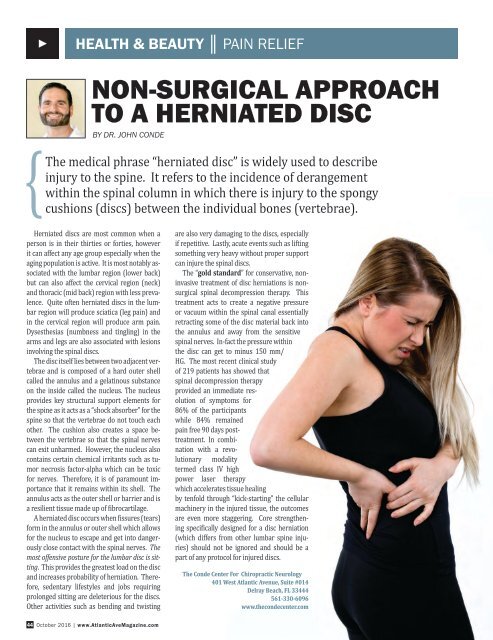Create successful ePaper yourself
Turn your PDF publications into a flip-book with our unique Google optimized e-Paper software.
►<br />
health & beauty ║ pain relief<br />
{<br />
Non-Surgical Approach<br />
to a Herniated Disc<br />
By Dr. John Conde<br />
The medical phrase “herniated disc” is widely used to describe<br />
injury to the spine. It refers to the incidence of derangement<br />
within the spinal column in which there is injury to the spongy<br />
cushions (discs) between the individual bones (vertebrae).<br />
Herniated discs are most common when a<br />
person is in their thirties or forties, however<br />
it can affect any age group especially when the<br />
aging population is active. It is most notably associated<br />
with the lumbar region (lower back)<br />
but can also affect the cervical region (neck)<br />
and thoracic (mid back) region with less prevalence.<br />
Quite often herniated discs in the lumbar<br />
region will produce sciatica (leg pain) and<br />
in the cervical region will produce arm pain.<br />
Dysesthesias (numbness and tingling) in the<br />
arms and legs are also associated with lesions<br />
involving the spinal discs.<br />
The disc itself lies between two adjacent vertebrae<br />
and is composed of a hard outer shell<br />
called the annulus and a gelatinous substance<br />
on the inside called the nucleus. The nucleus<br />
provides key structural support elements for<br />
the spine as it acts as a “shock absorber” for the<br />
spine so that the vertebrae do not touch each<br />
other. The cushion also creates a space between<br />
the vertebrae so that the spinal nerves<br />
can exit unharmed. However, the nucleus also<br />
contains certain chemical irritants such as tumor<br />
necrosis factor-alpha which can be toxic<br />
for nerves. Therefore, it is of paramount importance<br />
that it remains within its shell. The<br />
annulus acts as the outer shell or barrier and is<br />
a resilient tissue made up of fibrocartilage.<br />
A herniated disc occurs when fissures (tears)<br />
form in the annulus or outer shell which allows<br />
for the nucleus to escape and get into dangerously<br />
close contact with the spinal nerves. The<br />
most offensive posture for the lumbar disc is sitting.<br />
This provides the greatest load on the disc<br />
and increases probability of herniation. Therefore,<br />
sedentary lifestyles and jobs requiring<br />
prolonged sitting are deleterious for the discs.<br />
Other activities such as bending and twisting<br />
are also very damaging to the discs, especially<br />
if repetitive. Lastly, acute events such as lifting<br />
something very heavy without proper support<br />
can injure the spinal discs.<br />
The “gold standard” for conservative, noninvasive<br />
treatment of disc herniations is nonsurgical<br />
spinal decompression therapy. This<br />
treatment acts to create a negative pressure<br />
or vacuum within the spinal canal essentially<br />
retracting some of the disc material back into<br />
the annulus and away from the sensitive<br />
spinal nerves. In-fact the pressure within<br />
the disc can get to minus 150 mm/<br />
HG. The most recent clinical study<br />
of 219 patients has showed that<br />
spinal decompression therapy<br />
provided an immediate resolution<br />
of symptoms for<br />
86% of the participants<br />
while 84% remained<br />
pain free 90 days posttreatment.<br />
In combination<br />
with a revolutionary<br />
modality<br />
termed class IV high<br />
power laser therapy<br />
which accelerates tissue healing<br />
by tenfold through “kick-starting” the cellular<br />
machinery in the injured tissue, the outcomes<br />
are even more staggering. Core strengthening<br />
specifically designed for a disc herniation<br />
(which differs from other lumbar spine injuries)<br />
should not be ignored and should be a<br />
part of any protocol for injured discs.<br />
The Conde Center For Chiropractic Neurology<br />
401 West <strong>Atlantic</strong> <strong>Ave</strong>nue, Suite #014<br />
Delray Beach, FL 33444<br />
561-330-6096<br />
www.thecondecenter.com<br />
44 <strong>October</strong> <strong>2016</strong> | www.<strong>Atlantic</strong><strong>Ave</strong><strong>Magazine</strong>.com


















